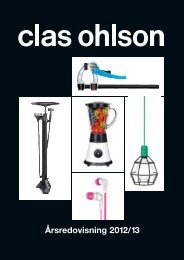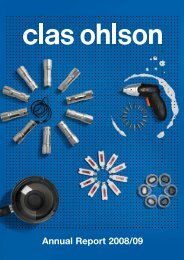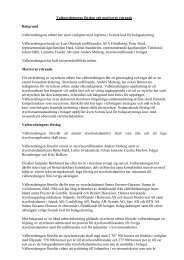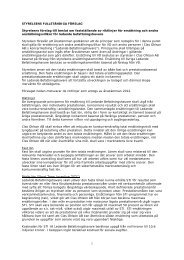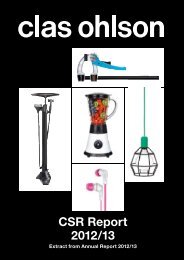Annual Report 2012/13 - Clas Ohlson
Annual Report 2012/13 - Clas Ohlson
Annual Report 2012/13 - Clas Ohlson
Create successful ePaper yourself
Turn your PDF publications into a flip-book with our unique Google optimized e-Paper software.
Pensions<br />
The members of the Board do not receive any pension<br />
benefits for their Board engagements.<br />
The retirement age for the CEO and for other senior<br />
management is 65. The CEO has a defined-contribution<br />
pension into which SEK 1.6 M was paid during the year.<br />
Other members of senior management receive pension<br />
entitlements based on their applicable ITP plan, which also<br />
covers other salaried staff in Sweden.<br />
Remuneration principles<br />
The general principles of remuneration for senior management<br />
are to be based on the position held, individual performance,<br />
the Group’s financial results and the remuneration<br />
being competitive in the country of employment. The<br />
combined remuneration of senior management shall consist<br />
of basic salary, variable salary in the form of a shortterm<br />
incentive based on annual performance objectives,<br />
long-term incentives based on performance over several<br />
years, pension and other benefits. In addition to this, there<br />
are terms applicable on notice of termination and severance<br />
pay.<br />
<strong>Clas</strong> <strong>Ohlson</strong> shall strive to offer a competitive total level<br />
of remuneration, focusing on payments based on performance.<br />
This means that variable remuneration may comprise<br />
a significant portion of total remuneration. The aim is<br />
for fixed remuneration to be in line with the median of the<br />
comparable market, while total remuneration, when <strong>Clas</strong><br />
<strong>Ohlson</strong> AB meets or exceeds its objectives, shall be in the<br />
upper quartile of the market. For further information about<br />
remuneration, refer to Note 6 on pages 67-69.<br />
Risk management<br />
The Board has overall responsibility for the Group’s risk<br />
effort. The risk situation in the <strong>Clas</strong> <strong>Ohlson</strong> Group is<br />
up dated and analysed regularly. This is done by means of<br />
a systematic process in which risks are identified, valued,<br />
assessed, managed, monitored and reported. Using an<br />
overall assessment, priority is given to those risks whose<br />
impact and probability are deemed to represent the most<br />
negative effect. A key aspect in this work is the measures<br />
undertaken to avoid (control activities), reduce or shift<br />
the risk to another party (insurance). The risks are entered<br />
in risk maps in order to clarify the overall risk exposure.<br />
Mapping is done at the Group level and represents a tool<br />
for operational and strategic governance by the Board<br />
and the company’s executive management. By means<br />
of risk mapping, the focus can be aimed at reducing the<br />
company’s risk exposure and reducing the consequences<br />
of any risks emerging. The Group’s Risk Committee<br />
pursues the work involved in compiling, monitoring and<br />
de veloping risk programmes. <strong>Report</strong>ing of the Group’s<br />
overall risk status is made internally to the Audit Committee<br />
and the Board twice annually (refer also to pages<br />
24-26 and Note 2 pages 66-67).<br />
Sustainability<br />
For <strong>Clas</strong> <strong>Ohlson</strong>, it is important to protect and assume<br />
responsibility for people and the environment impacted<br />
by our operation. The sustainability effort is an integrated<br />
part of <strong>Clas</strong> <strong>Ohlson</strong>’s operation, which must permeate<br />
the entire organisation. The company’s sustainability<br />
programmes are led by the CSR forum comprising<br />
the CEO, representatives from Group Management and<br />
various specialists within the relevant areas. The CSR<br />
forum makes decisions pertaining to goals, strategies<br />
and activities for the entire Group’s sustainability programmes<br />
and monitors whether the company is working<br />
effectively toward its set goals.<br />
In sustainability work, the Code of Conduct is the basis<br />
of the work to monitor and improve the supplier chain.<br />
<strong>Clas</strong> <strong>Ohlson</strong>’s Code of Conduct contains the requirements<br />
we place on ourselves, our manufacturers and suppliers<br />
with respect to the work environment, working conditions,<br />
environmental impact and anti-corruption.<br />
Internal control pertaining to<br />
the financial reporting<br />
The Board has overall responsibility for the company’s<br />
systems pertaining to internal control. The responsibility<br />
is regulated by the Swedish Companies Act, which also<br />
states that the Audit Committee has a specific responsibility<br />
for monitoring quality assurance in risk management<br />
and internal control regarding the financial reporting.<br />
The company’s work on internal control follows the<br />
framework developed by The Committee of Sponsoring<br />
Organisations of the Treadway Commission (COSO). The<br />
framework consists of five individual areas: control environment,<br />
risk assessment, control activities, information<br />
and communication and follow-up.<br />
Risk management<br />
Decision about<br />
overall policies<br />
The Board<br />
Monitoring<br />
Audit Committee<br />
<strong>Report</strong>ing<br />
Implement, delegate<br />
Establish guidelines<br />
and instructions,<br />
educate,<br />
compile reports<br />
Group Management<br />
Risk Committee<br />
Governance<br />
Monitor existing risks,<br />
identify new risks,<br />
report<br />
Function manager<br />
54<br />
Corporate governance




